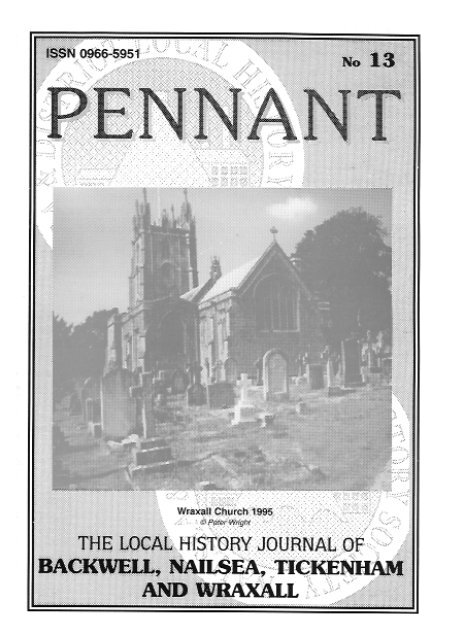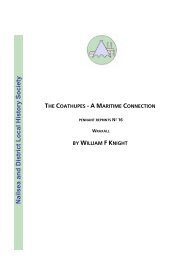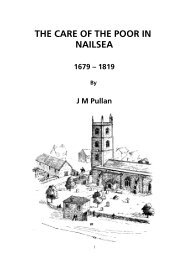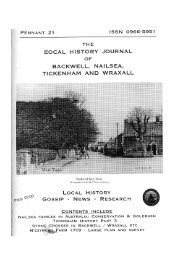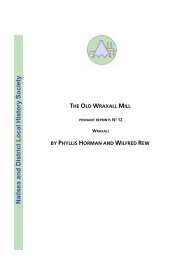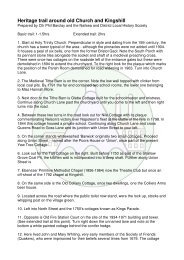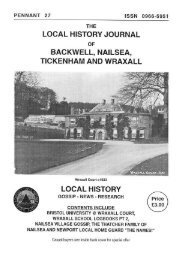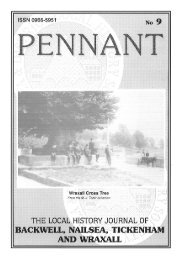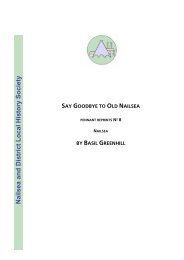Pennant 13 - Nailsea and District Local History Society
Pennant 13 - Nailsea and District Local History Society
Pennant 13 - Nailsea and District Local History Society
- No tags were found...
You also want an ePaper? Increase the reach of your titles
YUMPU automatically turns print PDFs into web optimized ePapers that Google loves.
Previously published by <strong>Nailsea</strong> & <strong>District</strong> <strong>Local</strong> <strong>History</strong> <strong>Society</strong>.This ebook version, © The respective authors <strong>and</strong> <strong>Nailsea</strong> &<strong>District</strong> <strong>Local</strong> <strong>History</strong> <strong>Society</strong>, PO Box 1089, <strong>Nailsea</strong> BS48 2YP,has been made available in April 2008, so that an individual maydownload <strong>and</strong> read this document, for private research purposesonly. It must not be reproduced or passed to a third partywithout written permission of the copyright holders.
<strong>Society</strong> News9 October 1995 - Brief Summary of Annual GeneralMeetingThe <strong>Society</strong>'s AGM was held at <strong>Nailsea</strong> Library with a goodturnout of members. Dr Notton stood down from the Committeebut the remaining committee members were re-elected. CecileBraid remained on the Committee but stood down from the taskshe has done so well over the last few years namely that ofProgramme Secretary. In doing so she has left us with a veryinteresting programme for 1996. As a result her successor willhave an easy first year. Sadly nobody volunteered at the AGM totake her place.The <strong>Society</strong> holds a large <strong>and</strong> varied stock of books <strong>and</strong> fundsare adequate to enable our programme to continue.Subscriptions were due in October, if you read this <strong>and</strong> realisethat you have not yet paid please hasten to do so.InformationWhere possible N&DLHS is always willing to assist those with aninterest in local history <strong>and</strong> local families. Unfortunately there arefew of us with the knowledge of past events <strong>and</strong> thewhereabouts of current records that can provide this service.Please encourage your friends <strong>and</strong> acquaintances (especiallythose with children at school) to make the most of theinformation available at the library. It is amazing the number ofqueries that are directed at our few willing members that couldhave been resolved by the questioner had he or she spent 15minutes in <strong>Nailsea</strong> library.
Brockley <strong>and</strong> Chelvey By Jim PullanThis book has been out of print for several years <strong>and</strong> we felt thatit may now be time to consider re-publishing this in A5 format.Dave Robbins is busy preparing the text. When this is ready theCommittee will consider the costs <strong>and</strong> likely sales beforeproceeding further.Noah's Ark by Gwyneth ParkerDave Robins has put this on disk <strong>and</strong> we will be preparing thisfor publication in limited numbers during the Spring of 1996War MemorialsPeter Wright will eventually produce a booklet which willcombine details of all the memorials in our area of interest <strong>and</strong>will include exp<strong>and</strong>ed versions of the articles currently beingpublished in PENNANT.He seeks information / photographs of anyone named thereon orwho gave their life during the past wars <strong>and</strong> police actionsduring peacetime. This will of course include persons from thearea who died serving on humanitarian missions <strong>and</strong> those bornoutside of our area who died in the four parishes while servingtheir country. (egg aircrew who were killed in local crashes <strong>and</strong>soldiers who died at Tyntesfield Hospital).If anyone has details please contact the editor.Weston-super-Mare Family <strong>History</strong> <strong>Society</strong>By the time that you read this we will have received a talk fromthe Weston Super Mare Family <strong>History</strong> <strong>Society</strong> <strong>and</strong> this remindsme that we have an arrangement to exchange journals with that<strong>Society</strong>. If members want to know what is going on at WSMFHSthey can borrow a copy of the latest journal but I would befailing in my duty if I did not encourage members of N&DLHS(who are interested in Family <strong>History</strong> especially with ancestorsfrom the immediate area) to join the relevant Family <strong>History</strong>
<strong>Society</strong>. WSMFHS has just produced a booklet of MembersInterests. If you would like a copy telephone George Knox 01275791261 for details. NB new phone number.Other Publications now out of PrintAny member wishing to help put these on disk contact theEditor.Termination of "Books on Approval" scheme The decision hasbeen taken with some regret to terminate this scheme. Futurebooks will usually be produced with an initial run of about 100copies.The War Memorial at Christ Church <strong>Nailsea</strong>CorrectionIn PENNANT 11 the list shown on the inside back cover of namesthat appear on the memorial contains two errors. Please amendyour copy.W J BKER should read W J BAKERH O BAR should read H O BAKER <strong>and</strong>L H KINGHARMAN should read L H KING-HARMANLetters to the EditorFrom Mr J A Jouniaux, Fleurus, BelgiumThis followed some astute detective work by John "HerculePoirot" Christiansen.Mr Jouniaux writes to say that he spent the war years in Backwell<strong>and</strong> had attended the Hammersmith School while there. He iswilling to write down his memories. While in Backwell hebecame a friend of John Christiansen. They lost touch more thanforty years ago when John was in the forces <strong>and</strong> about to go toGermany while Mr Jouniaux was leaving for the Belgian Congo.
From information given in his second letter I discovered that welived for part of 1940 less than 1 mile away from each other inHornsey North London.From Mr & Mrs R Tyree, Otago, New Zeal<strong>and</strong>.Mrs Tyree a descendant of the Coombs (Coombes / LyallCoombes) families wrote having been given my name by "Bid"Wheeler who she met in <strong>Nailsea</strong> while on a tour of the BritishIsles.She enclosed a copy of information she had about the family tree<strong>and</strong> a rubbing from a brass plate. This latter item was identical toone I received last year (see <strong>Pennant</strong> 8) from Freda Hewitt, alsofrom NZ. I have written to Mrs Tyree giving her the address ofher "cousin". If anyone has information about the family wholived at Mizzeymead <strong>and</strong> Coombe Grange Farms please let theEditor know.From Somerset Record OfficeIn reply to a query from me about what they had that mightassist research into the War Memorials in Tickenham <strong>and</strong> Wraxallthey mentioned that there is a gap in the series of vestry/PCCminutes held at Taunton covering the period of the WarMemorials for Tickenham. At the inspection in 1979 theTickenham parish held Parochial Church meeting minutes from1920 <strong>and</strong> PCC minutes from 1922. SRO suggests we makeenquiries locally. Does anyone have information?SRO also gave the following references which may assist readers."There is a register of services which may give the date of thededication service after the Second World War under thereference D/P/tick 2/5/.
Items that may interest readers which relate to Wraxall are asfollows. That relating to the unsuccessful attempt by Mr Kilmisterto erect a seat in the church follows later.S/1096 D/P/Wrax4/1/5 1896-1931Accounts to 1920; vestry mins (joint with PCC from1925) 1 volList mems Wraxall Bell Ringers Soc with printed rules 19069. Vestries <strong>and</strong> other meetings9/1 Vestry Meeting Minute BooksSee also 4/1/1-59/1/1 1831-1970 Vestry Minutes 1 volCIVIL<strong>13</strong>. Office <strong>and</strong> functions of the Overseers of the Poor<strong>13</strong>/2 Accounts<strong>13</strong>/2/1.1707-1761 Joint accounts <strong>and</strong> rates for Overseers 1 volchurchwardens <strong>and</strong> way wardens (note re Elton& Marchioness of Northampton Gifts 1808)<strong>13</strong>/2/2 1762-1792 Overseers accounts to 1783 rates to 1772 1 volnotes concerning unsuccessful attempt byJn. Kilmister to erect a seat in the church 1770<strong>13</strong>/2/3 1793-1836 Overseers accounts <strong>and</strong> rates 1 vol<strong>13</strong>/2/4 1836-1848 Overseers accounts 1 vol<strong>13</strong>/3 Settlement Papers<strong>13</strong>/3/1.1831 Removal order to Wraxall 1 doc14 Office <strong>and</strong> Functions of the Waywarden14/5 Accounts(for accounts 1707-1761 see <strong>13</strong>/2/1/above)14/5/1.1790-1820 Accounts 1 vol
14/5/2 1820-1836 Accounts 1 volThis list provided by Somerset Archive <strong>and</strong> Record Service <strong>and</strong>printed with their permission.NB IF YOU WANT TO VISIT THE SEARCHROOM YOU MUST MAKE ANAPPOINTMENT. SRO APPOINTMENTS ONLY Tel No “redacted”Churchwardens Accounts of All Saints WraxallCopied from the original by Phyllis HormanPrepared for <strong>Pennant</strong> by the Editor.Published with appropriate acknowledgement to the SRO.Whereas a citation from the Ecclesiastical Court of Wells dated17 Oct 1770 was affixed to the church door at Wraxall on Sun28th day of the said month requiring the Minister <strong>and</strong>Churchwardens to appear at Wells on the 30th of the samemonth to show cause why a faculty should not be granted toJohn Kilmister to erect a seat in the said church. In the saidcitation it is among other things alleged that opposite the clerk'sseat there are two seats or benches extending to the South tothe North Alley of the said church <strong>and</strong> bounded eastwards with across alley which parts the same from two seats belonging to MrMartindale <strong>and</strong> Mr Hollester to which seats no person what everhath any right or claim <strong>and</strong> therefore the said John Kilmisterprayed to have a faculty to erect a pew on part of the ground ofthe said two seats opposite to Mr Hollester's seat to abut on thesaid South alley to contain six feet each way <strong>and</strong> to have thesame to himself exclusive of all others.In pursuance of the said citation the Minister with theChurchwarden <strong>and</strong> farmer Vowles (Sir Chas Tynt's tenant) didappear at Wells Court on Tues the said 30th day of October but
as Mr Jason the Proctor was through illness unable to attend thatday the Court adjourned the cause to Tues <strong>13</strong>th Nov following.In the meantime a vestry was summoned to be held in theChurch on Sunday 4th of said Nov at which vestry were presentviz. The Rev Mr Phelps, curate, George King, Churchwarden,Walter King Esq., Mr Matthew, Mr Hollester, John Vowles Junr,Wm Knight, Robert Askey, John Kilmister <strong>and</strong> Jas. Martindale.When the whole proceedings were fully laid out before them<strong>and</strong> in order to consider more maturely of the business the saidvestry was adjourned to Fri the 9th day of the said month whenthe following persons attended viz. The Rev Mr Phelps, curate,George King, Churchwarden, Walter King Esq., Mr Matthew, MrHollester, Thomas Jenkins <strong>and</strong> Jas. Martindale when theyunanimously approved the steps which had already been takenby the churchwarden <strong>and</strong> agreed to oppose the said citation <strong>and</strong>ordered that Mr Phelps <strong>and</strong> John Vowles be desired to go toWells again <strong>and</strong> employ Mr Jason for that purpose, at theexpense of the parish. On the <strong>13</strong>th of said month Mr Jasonappeared at Wells Court <strong>and</strong> gave such substantial reasons whythe faculty ought not to be granted but said Kilmister's proctorMr Sutton having prayed further time the cause was adjournedto the next Court Day. But when that day came Mr Suttonhaving nothing further in favour of his client's cause, the Courtthought fit to dismiss the cause.DISBURSEMENTS OF GEORGE KING AND PETER GRIFFIN1770-1771Mar 30th To horse hire expenses <strong>and</strong> trouble for Mr PhelpsFarmer Vowles <strong>and</strong> myself when we went to wells on 30thOctober last to appear to Mr Kilmister's citation £1-05s-0dPaid to Mr Phelps <strong>and</strong> Farmer Vowles chaise-hire expenses <strong>and</strong>trouble when they went to Wells to oppose the sd citation on<strong>13</strong>th Nov. By order of the Vestry£1-16s-4d
April 10th 1773 Paid to Mr Tuson's (?Jason's) Proctor at Wellshis bill in John Kilmister's affair £1-08s-2dThe Royal British Legion Roll of Honour for<strong>Nailsea</strong>as read at the Remembrance Day ServicePeter WrightAs I write this article Remembrance Day is but 9 days away. Asmany of you will have noticed there are discrepancies betweenthe names commemorated on the War Memorials at ChristChurch <strong>and</strong> Holy Trinity Churches. It is my intention to resolvethese before the <strong>Society</strong> publishes its book about the memorials<strong>and</strong> the individuals named thereon in 1996/7. However there issome urgency about resolving the following discrepancy asquickly as possible so that due recognition can be given to thosewhose names appear on one of the memorials but who are notmentioned at the service.I had assumed that as the Remembrance Day parade takes placeat Holy Trinity it had always done so <strong>and</strong> that the list of namesread out at the service was a list of those whose names appearedon the memorial at Holy Trinity. Accordingly I approached theBritish Legion <strong>and</strong> pointed out that the names they readpresumably omitted M Lock whose name appears only at ChristChurch.Having been proved wrong in that M Lock was included on theirlist we looked further <strong>and</strong> find that there are four names omittedfrom their list <strong>and</strong> those names are those that appear only on theHoly Trinity memorial. More to my surprise was the informationthat Christ Church War Memorial is the official <strong>Nailsea</strong> WarMemorial <strong>and</strong> that between the wars was the site of theRemembrance Day Service. Does anyone have memories of these
services or knowledge of how the move to Holy Trinity cameabout?Comparing the list used by the Royal British Legion it appears tohave been copied from the information used to produce the listat Christ Church of those fallen in the Great War 1914-1918 <strong>and</strong>the similar information used to add the names of the fallen inWW2 to Holy Trinity memorial although the order of namesseems to accord more closely with the list at Christ Church.I have been asked to ascertain what I can regarding the fourpersons that are currently not mentioned at the RemembranceParade. If any reader can give me the name of any living relativeof the four <strong>and</strong> the circumstances in which the last three of thefollowing died <strong>and</strong> when <strong>and</strong> where they were buried I will passthe information onto the Royal British Legion.A G Badman Pte 2nd Wessex RE wounded France 1915 died<strong>Nailsea</strong> of wounds 1922A Durbin 1st Rifle Brigade France 1918F W Toombs 3rd Batt Glos Regt Fl<strong>and</strong>ers 1915R G Tyler Lce Cpl 8th Batt Duke of Cornwalls L I Salonica 1917
The Thatchers, the Farlers <strong>and</strong> a house called"Trostry"by Phyllis HormanI was sorry to learn recently of the death in Canada of MrsThatcher whose father in law was Herbert Edwin <strong>and</strong> whoseancestors were the Thatchers of <strong>Nailsea</strong> who started the brewery<strong>and</strong> caused the Friendship Inn to be built.I had met both her <strong>and</strong> her husb<strong>and</strong> when they visited Engl<strong>and</strong><strong>and</strong> was pleased that their son Tony, who wrote to tell me of herdeath, was interested in the family history. I was able to sendhim several items <strong>and</strong> met him <strong>and</strong> his (sister / wife?) when theycame to Engl<strong>and</strong> recently.Tony's mother had been keen to find a house (built in Wraxall forher husb<strong>and</strong>'s parents) which had been named "Trostry". Shehad seen it many years ago but had forgotten the exact location.Tony remarked in one of his letters"Thinking about "Trostry" my gr<strong>and</strong>father (Herbert Edwin) livedfor a number of years around the turn of the century in Newport,Mon. running the other Thatcher Brewery on Mountjoy Street. Isee that there is a street called Trosty in Newport not far fromthe Brewery <strong>and</strong> I wonder if the name originated there...."In the same letter he also said"Regarding the Farlers, we hold a photograph of John Farler whowas reputedly the governor (or on his staff) of Zanzibar. He iswearing a fez <strong>and</strong> (it) was taken last century. I wonder if he wasthe eldest son of John Farler of Coal Pit fame. Another littlemystery!"
On Wednesday 2 Aug 1995 I met Tony <strong>and</strong> his wife (or was it hissister? I don't know) <strong>and</strong> his daughter at <strong>Nailsea</strong> Library <strong>and</strong> wehad a "Gr<strong>and</strong> Tour" of the area of most interest to him.To begin with we went to Christ Church where I pointed out thecorner where many Thatchers <strong>and</strong> Farlers are buried. We thenwalked to the Friendship where I pointed out where the brewery<strong>and</strong> water tower had been, <strong>and</strong> looked at Heath House.Back we went to Clevedon Road car park where they had parkedtheir car <strong>and</strong> so the "tour" commenced.They wanted to see Back lane so we went down WhitesfieldRoad (originally Back Lane) along Queens Road <strong>and</strong> HannahMore Road to The Grove <strong>and</strong> Holy Trinity Church. Here we foundthe Thatcher great gr<strong>and</strong>parents grave with other members oftheir family buried with them.Next we went to Farlers End to see the tower of Farlers Pit. On toRosemount now Trendlewood House where John Farler <strong>and</strong>family lived. Unfortunately this is almost impossible to see. Tonyeven picked the daughter up on to his shoulders to see if shecould take a photo, but the wall was too high, this was their onlyreal disappointment.We then went to Wraxall <strong>and</strong> up Tower House Lane as thisseemed the most likely area to look for "Trostry" We werealmost at the top when Tony's wife / sister recognised the road.She had been here a few years ago <strong>and</strong> had "Trostry" pointedout to her. She pointed at the house now named "Sunrise" asbeing very like "Trostry"We then went along the top road to Wraxall Hill <strong>and</strong> down to AllSaints Church. About three years previously Tony had been toEngl<strong>and</strong> for a few weeks <strong>and</strong> had visited Wraxall Church <strong>and</strong>located his gr<strong>and</strong>father's grave. This year he was able to go
straight to the grave again. You can imagine the number ofphotos taken during the morning.We came back to <strong>Nailsea</strong>, the "tour had taken two hours <strong>and</strong> Imust say it was two hours of real pleasure in exceedinglypleasant company.Early Crime in the <strong>Nailsea</strong> <strong>District</strong>by Derek B LillyVillage Pump <strong>Local</strong> <strong>History</strong> Research GroupIn the 18th <strong>and</strong> early 19th centuries petty criminals were mainlycaught not because of the cleverness of the local constables, butmostly because of the lack of forethought on the part of theculprits.A farmer from <strong>Nailsea</strong> named Godwin appears in all of the threecases which follow (it seems likely to have been the sameperson).The name crops up first on the 2nd day of September 1785.The witnesses Joseph Crow, John Elliot, John King <strong>and</strong> John Hiattall stated that"- John Godwin of the Parish of <strong>Nailsea</strong>, in their presence <strong>and</strong>hearing did tell their master Isaac White that if he did not move aWheel House which was erected over a Coal pit in the said parishof <strong>Nailsea</strong> in the said County belonging to Joseph Whitchurch,Peter Cox <strong>and</strong> him the said Isaac White within three days the saidJohn Godwin would cut it to pieces <strong>and</strong> burn it to the Ground.And sayed in order to bind it he would be damned if he did not -And all these informants say that the said wheelhouse wasactually set on fire <strong>and</strong> burnt to the ground the second day of
August last between twelve <strong>and</strong> one o'clock in the Morning, Andthey all severally say they believe on account of the said JohnGodwin's threatenings as aforesaid that he or some other personor persons by his order did set the said Wheel House on fire"Unfortunately we do not know the results of this case, it is onethat was not recorded on the roll.Farmer Godwin is in the courts of Quarter Session 15thDecember 1785. This time as a complainant. His sister Mary (wifeof Isaac Brown a butcher) giving evidence against his servantMary Williams, whom she alleged was passing her brother'sgoods to her friends:-Mary Williams she claimed"..Asked her if she had shut her brother's door for she had somecream to give to Molly Bird (meaning William Hedges's wife) <strong>and</strong>that if her master knew he would be very angry - saith she -threw her apron over the cream which was in a tumbler thatmight hold near half a pint, <strong>and</strong> carried it into the porch calledsaid Hedges's son <strong>and</strong> gave him the cream."Godwin was quick to state that he had several times missed suchthings as "milk, cream, butter <strong>and</strong> baked cakes". Yet he had notdismissed Mary Williams, so it would appear that he was not sureof this. Another servant of his Abraham Windsor bore witness aswell, but I would imagine that his evidence was regarded aspetty spite by the Justices; because for this case we have writtenin on the roll :"William Hedges, Caleb Hedges, Mrs Williams, Bills of Indictmenthaving been proposed against them but the same having beenreturned IGNORAMUS let them be discharged"
House <strong>and</strong> Pantry - all of which she delivered to the said SarahWindsor who put the whole in her Pocket H<strong>and</strong>kerchief. - saidSarah Windsor immediately took them out of the House - (<strong>and</strong>)put them under a Hay Mow in a field called the Nine Acresbelonging to the said Alex<strong>and</strong>er Coombes".Sarah Edghill was found guilty <strong>and</strong>"Having been convicted of Gr<strong>and</strong> Larceny let her be imprisonedin the Gaol at Ivelchester for three days".There are two pleasures in dredging through the old QuarterSessions rolls for court cases <strong>and</strong> settlement orders. First is theentertainment given by their styling <strong>and</strong> phrasing of ourlanguage. Secondly there is the linking of names in our village tothe trades these people occupied <strong>and</strong> the consequent fitting inof another "jigsaw puzzle piece"In Clevedon we had long been aware of one Richard Cox a smallfarmer, but a case of stealing hay in Tickenham, with he <strong>and</strong>Farmer Doggett as witnesses gives him as by trade a "taylor". Itseems that "Moonlighting" is not a modern invention at all.Occasionally one is surprised to find family involved. My Greatgreat gr<strong>and</strong>father John Lilly who lived at Mary's Garden onCadbury Camp featured in a case of punching Richard Cox, hewas sent to Wilton Gaol for six months as a result. Our familybelieve that he deserves a posthumous award, Richard Cox atthat time was the local Tax Assessor.(for other local crime stories see "<strong>Nailsea</strong> Village Gossip" byPhyllis Horman available from the Editor price £2-50 inc p&p)
The Brockley Elephantby Gordon <strong>and</strong> Ailsa Walker(© the authors <strong>and</strong> printed with their permission)In the Autumn of 1994 an elephant skull was kindly given toBristol Zoo by a Mr Garl<strong>and</strong> <strong>and</strong> is now on display in the ActivityCentre.In 1958 Mr Garl<strong>and</strong> was working at Backwell School where theScience teacher was wanting to build up a natural historycollection <strong>and</strong> had asked his pupils to bring along anything theythough might be suitable. One boy had found a large skull in thewoods on Backwell Hill which he thought was from a cow or ahorse but when it was brought to the school was identified as anelephant. It remained in the School Science Department <strong>and</strong>subsequently in the Art Department for some 36 years <strong>and</strong>would have been thrown away but for Mr Garl<strong>and</strong>recommending it should be donated to the Zoo for educationalpurposes.The skull is of an Asian Elephant which had probably lived to bearound 20 to 25 years of age. It is without tusks but retains itsfull set of four teeth. The lower jaw is now being displayedseparately from the remainder in order to preserve the wholefrom further damage.We thought it might be interesting to examine the strange factof an elephant apparently having died in the woods some 10miles south-west of Bristol.A booklet written c1980 by Jim Pullan ("Brockley <strong>and</strong> Chelvey"published by <strong>Nailsea</strong> <strong>and</strong> <strong>District</strong> <strong>Local</strong> <strong>History</strong> <strong>Society</strong> currentlyout of print but soon to be republished in the <strong>Pennant</strong> SpecialSeries) includes a reference to
"A small building near Brockley Cottage, built during the 18thcentury, is said to have been intended to house an elephant thatwas used to haul timber from the woods. An inscribed stone inan end wall gave the date 1789 with, presumably, the initials ofthe owner "J.P." The building was converted a few years agointo a cottage now called "Pigotts".The importance of this piece of information lies in the fact thatBrockley <strong>and</strong> its woods are adjacent to the woods of Backwell<strong>and</strong> that the whole of the l<strong>and</strong>, even as far as Weston superMare, once belonged to the Pigott family.John Pigott of Brockley Court was a Member of Parliament forSomerset 1705-1707 <strong>and</strong> had purchased the l<strong>and</strong>s <strong>and</strong> manorsof Weston in 1696. He married Florence Smyth of Ashton CourtBristol, <strong>and</strong> their descendant was John Pigott (b1741 - d1816).There is little doubt that the initials "J.P." on the preserved stonedated 1789 refer to the latter gentleman.Nikolaus Pevsner, historian of Engl<strong>and</strong>'s churches <strong>and</strong> ancientbuildings, in his 1958 publication "North Somerset <strong>and</strong> Bristol"contains a paragraph on Brockley Court <strong>and</strong> Brockley Cottagewhich includes the following "There is a persistent rumour thatone of the outbuildings was originally an Elephant House erectedby the East India Company for an elephant they had broughtover".Research into the history of the Pigott family has so far notrevealed a connection with the East India Company. We havecorresponded with living members of the family <strong>and</strong> apart fromone having actually lived in Brockley Cottage many years ago <strong>and</strong>having a clear recollection of the building known as the ElephantHouse was unable to provide further information.
It is recorded that John Pigott was "widely travelled" <strong>and</strong> wasbeing repatriated from France during the Napoleonic Wars whenhe died in Calais in 1816.On our visit to Brockley the present tenants of the Cottage werekind enough to show us the Elephant House <strong>and</strong> much to oursurprise an elephant bath in their garden. This large hole has acobbled slope leading down into the water. It is sufficientlyproportioned <strong>and</strong> would have been an ideal structure in which avery large animal could bathe.The certainty that John Pigott owned an elephant in ruralEngl<strong>and</strong> in 1789 leaves us speculating on its life style <strong>and</strong> themanner of its death at a comparatively early age.Merchants <strong>and</strong> wealthy travellers in those days would haveencountered elephants as beasts of burden in Asia (Hannibal hadthe benefit of them when crossing the Alps in 215 B.C.).Did John Pigott buy or import the beast or was he favoured witha gift from some noble Maharajah? It would undoubtedly havebeen of great value for logging in the extensive woodl<strong>and</strong> on thePigott estate <strong>and</strong> a great status symbol! Did it die of overwork oran unsatisfactory diet or was the British Climate finally toounbearable? At least it would seem to have had care <strong>and</strong>consideration, witness the shelter of an Elephant House <strong>and</strong> theprovision of a bath.One wonders how many elephants may have ended their days inBritain over 200 years ago?
My introduction to the <strong>Nailsea</strong> <strong>Local</strong> <strong>History</strong>Groupby Peter WrightI am delighted that Jim Smith has given me a brief note of howthe local Junior Football club was founded as it was whilerunning the line at Scotch Horn for my son's team that I saw twomen nearby measuring the old stonework.In a lull in the game I asked them what they were doing. Theytold me they were measuring the site of the Glassworks. Iexpressed interest <strong>and</strong> they introduced themselves as TrevorBowen <strong>and</strong> Harry Dommett. Trevor said that there was a localhistory group <strong>and</strong> he would let me know when the next meetingwould take place. I was duly invited to a meeting which tookplace in the library. For some reason there was no secretary <strong>and</strong>they needed someone to take the minutes. 19 years on theconsequences of my volunteering make a separate story!Becoming involved with the club led to some lasting friendshipsas well as a strange introduction for Joan <strong>and</strong> myself to nearbyvillages. For some time when discussing a village we would haveto ask a question such as "Is that the one with the slopingfootball pitch"? A strange introduction to the area but onewhich we enjoyed. Now to the start of Junior Football in <strong>Nailsea</strong>.
<strong>Nailsea</strong> Junior Football Club The beginningby Jim SmithBecause there were 5 boys playing for South Avon Schoolboys in1973/74 but there was no local junior football club Jim Smith<strong>and</strong> Det Sgt Len Smith (no relation) decided that they would startone the following season.Adrian Davies who ran a sports shop in <strong>Nailsea</strong> was contacted<strong>and</strong> agreed to assist. Notices were put in his shop window <strong>and</strong>the Schools asking anyone interested to attend Grove Sports fieldat 6pm on a particular Monday evening.When Jim <strong>and</strong> Len arrived they found the place so crowded thatyou could hardly move for bikes <strong>and</strong> boys. There seemedhundreds of them, some with parents <strong>and</strong> some without.They started by splitting them according to age <strong>and</strong> takingdetails. Eventually the parents with Len <strong>and</strong> Jim repaired to theRing of Bells where, after some discussion a Committee wasformed.One of the first fund raising efforts was to collect oldnewspapers for recycling. At that time it was a practicableproposition as those collected could be sold for a reasonablesum.All the newspapers were delivered in small amounts to Jim'shouse where they were sorted <strong>and</strong> bundled in his garage beforebeing taken to Pam Wyatt's farm for storage until there wasenough to fill a lorry.
Adrian Davies supplied kits <strong>and</strong> footballs etc. The club's first billwas for £365 with nothing in the kitty until the first lot of paperwas sold.Jim Smith was the first Chairman <strong>and</strong> his wife became Treasurer<strong>and</strong> Secretary. (Ed. Jim can just be seen at the back of thephotograph accompanying this article).There were so many interested youngsters that two teams wereput out at each age group, the first team was called <strong>Nailsea</strong>United <strong>and</strong> the second team <strong>Nailsea</strong> Athletic. For technicalreasons the FA requires the sides to be run as two separate clubsalbeit with the same administrative officials.Twenty years have elapsed since then <strong>and</strong> the club has gonefrom strength to strength.(Editor's note - The current secretary of the club recently told me,at a meeting called for local organisations by the <strong>Nailsea</strong> Civic<strong>Society</strong>, that the Junior Football Club now caters for 300 boysaged from 8 to 16. It has two pitches off Greenfield Crescentwhich being in a low lying area makes them very vulnerable tobad weather.) ADROIT..ILLUSTRATION..IN ALBUM.......<strong>Nailsea</strong>United U12s 1977being presented with the cup by John Sillett atthat time Manager of Hereford United
Memories of Backwell schooldays in the 1930'sby John BrainAs a boy, back in the 1930's, I was an avid reader, including ofcourse the comics of the day. The "Hotspur" became my weeklydiet, <strong>and</strong> I still remember one of the school stories published in1935 - "At school in 1975" which fantasized about scholarstalking to one another over a television screen. What would theauthor have thought of the speed with which reality overtookthe fiction of 60 years ago!Nursery education, playschool, <strong>and</strong> all the other opportunities oftoday's world were totally absent in the 1930's, but our villageschool in Backwell was quite happy to take children from the ageof 4. I came into this category <strong>and</strong> arrived, accompanied by mymother on the first two or three mornings, after which you wereon your own, left to make tentative approaches to otheryoungsters to walk with them to <strong>and</strong> from school, <strong>and</strong> cultivateyour first early friendship.Like most village schools, church connections were strong, thebuilding being opened in 1862 on l<strong>and</strong> given by the Rector ofthe day, the Reverend Lord John Thynne, <strong>and</strong> largely funded bythe parish's patron <strong>and</strong> largest l<strong>and</strong>owner, the Marquis of Bath.When I joined its ranks in 1932 the headmaster was John HWebb, a man of many talents, who lost a leg in the first WorldWar, but who came home to serve the school with distinction fortwenty years <strong>and</strong> despite his disability, lived to the ripe old age of91. Whilst John taught the 10-14 class which included thosewho took the Secondary exam at 11 (with the prospect ofsecondary education in Bristol), his wife Sarah taught the 9-10group. Two local lady teachers, I suspect both uncertificated,covered the infants <strong>and</strong> the 7-9 groups. Firmness, <strong>and</strong> yet
kindness was the hallmark, although the need for the formerquality grew as we moved up the school!Backwell before the war was very much an agricultural village.Nothing changed very much, poverty was not unknownespecially in the larger families, but the sense of security <strong>and</strong>trust was far more apparent than it is today. The church wasnever locked, <strong>and</strong> its four silver c<strong>and</strong>lesticks remained in thechancel, with the silver alms dish on the altar throughout theyear - the idea of theft from the church in those days wasunthinkable.Discipline however was well maintained, <strong>and</strong> Mr Webb used thecane judiciously when the occasion arose, on the h<strong>and</strong> of course.Those of us who got it earned it <strong>and</strong> as parents almost invariablysupported the teacher, respect for authority was learned at anearly age.Church influence was strong. I still remember my firstimpressions in the infants class where we were taught by MissRossiter, the daughter of a local builder, <strong>and</strong> seeing largepictures depicting biblical scenes hanging from the walls. Theupper classes always sang a hymn, usually "Praise my soul theKing of Heaven" <strong>and</strong> said the Lord's Prayer before lessons, <strong>and</strong>at the end of day we sang:"Lord keep us safe this night Secure from all our fears Mayangels guard us while we sleep Till morning light appears". Forgood measure we sang "Be present at our table Lord" beforelunch, <strong>and</strong> "We thank thee Lord for this our food" when wecame back - all part of the daily ritual.The Rector of those days, Prebendary Urch, came in regularly totest our religious knowledge, as well as to pick out prospectiveboys voices for the church choir; I have to say that 60 years later Iam still a member, with a love of church music undimmed by the
passage of time. Both John <strong>and</strong> Sarah Webb were prominentchoir members; one of our other teachers, Mrs Hayward, sangsoprano, <strong>and</strong> was the wife of our long serving organist of thattime, Ernest Hayward, who in turn was a school attendanceofficer - church <strong>and</strong> school at Backwell were inextricably mixed.Reference has been made to our walking to school, <strong>and</strong> it'sworth remembering that boys <strong>and</strong> girls walked from Downsideover Backwell Hill, from the far end of Backwell Common <strong>and</strong>Chelvey <strong>and</strong> even the beginning of Cleeve - it was hardlysurprising that hob-nailed boots were quite commonplace.Although there is no comparison with today, our teaching wasthorough, <strong>and</strong> at an early age. Tables by rote was well learnt inthe first two or three years, <strong>and</strong> we were given a goodgrounding in English history <strong>and</strong> geography by the time we were9.During the spring <strong>and</strong> summer Mrs Webb would take her classon Backwell Hill for "nature walks", boys <strong>and</strong> girls separately,<strong>and</strong> we would come back with flowers <strong>and</strong> sprays of leaves, jarsof tadpoles <strong>and</strong> newts, which all became part of the classroom'sstock in trade, <strong>and</strong> naturally gave us a good insight into theworld of nature.There was also a large tract of l<strong>and</strong> behind the school across theroad leading down from Backwell Hill which was the site of theschool gardens, divided into vegetable plots, which older boyscultivated under Mr Webb's supervision - our introduction tonature was not merely decorative, but practical!School was not all work of course. Games evolved in theplayground; there was always a spirit of mild anarchy amongstus, <strong>and</strong> sometimes scores were settled. Backwell Hill was anatural playground during the lunch hour. There was a junior<strong>and</strong> a senior playground <strong>and</strong> woe betide a junior who ventured
through the narrow entrance to the "big boys" section: therewas always someone who would clip your ear for daring to entertheir preserve!We enjoyed the marble season <strong>and</strong> the conker season, <strong>and</strong> inOctober brought chestnuts to school to roast at dinner time onthe open fire in Mr Webb's room, sometimes deliberately leavingthem to explode, just to liven up the proceedings!Summertime too, meant the fruit was ripening, <strong>and</strong> I am afraidthat pinching apples from the various orchards on the way homefrom school was a harmless pursuit that was universally followed.In those days the "Morgan sweet" was grown by most farmers<strong>and</strong> formed part of our regular diet in addition to our tea.If you were caught you received summary justice; as few peoplehad telephones few incidents were reported to Mr Webb unlessthey came from the irate farmer whose orchard was bounded bythe school wall. Not many boys took that risk!These are but a few memories of my schooldays at Backwell'sJunior School, still happily going strong under its headmaster,Peter Turner. We were taught respect , discipline, <strong>and</strong> selfreliance- no "counselling" if you got the cane! Above all it leftme with a lasting high regard for our teachers, a pride in ourhistory, <strong>and</strong> an abiding love for the Church of Engl<strong>and</strong>.We left school numerate <strong>and</strong> literate, <strong>and</strong> I am not so surepopular opinion today doesn't have a sneaking regard for thest<strong>and</strong>ards which were instilled in us by our teachers of 60 yearsago. They all served Backwell's children well.Other articles in <strong>Pennant</strong> relating to Backwell schools include:-Cox R 07/08.Backwell Junior School Photo (back cover)Darbon C 08/06.Backwell Junior School PhotoKnight N 02/02.Early Schools in Backwell
Lambert B 08/14.Fairfield School, a Short <strong>History</strong> to 7/65Wright PC 08/07.<strong>Local</strong> Schools (Fairfield PNEU School)Articles relating to Education in general includeHorman P 04/14.Wraxall <strong>and</strong> Fail<strong>and</strong> SchoolsMilton C 04/02.150 yrs. Educ at C.Ch/ Four Oaks SchoolWright PC 08/07.<strong>Local</strong> Schools (memories wanted)Wraxall War MemorialInformation from DocumentsAlthough several people have tried to find out about how thememorial came into being <strong>and</strong> the names of those involved littleevidence has been unearthed. It seems that we will have to go toTaunton to investigate what is available at the Somerset RecordOffice.One item that has come to light is the following; an extract fromWraxall <strong>and</strong> Fail<strong>and</strong> Parish MagazineDecember 1920Armistice Day (November 11th) was observed at Wraxall, a bellbeing tolled a few minutes before 11am, when there was a shortsilence for two minutes from ordinary occupations. In theevening the bells were rung. On Sunday evening (November 7th)there was a special service at the Church, at which a largenumber were present <strong>and</strong> took part.-------------------------On Monday evening (November 8th) a meeting of the WarMemorial Committee was held at the Girl's School, Wraxall, Mr TR Davey of Wraxall Court presided. A letter from Col G A Gibbs,M P was read, in which he stated that he purposed presenting
the parish with some l<strong>and</strong> to be added to the Churchyard, <strong>and</strong>the meeting decided to erect the new War Memorial in thecentre of the new ground. It was decided that the Memorialshould take the form of a Cross. Several designs were submitted,<strong>and</strong> one of them was chosen by the votes of those present. Itwas considered generally that a Cross, as a Memorial, would bemore suitable than another form, to appeal to the presentgeneration.50 th Anniversary of VJ DayA service of Remembrance <strong>and</strong> Committment to mark the 50thanniversary of the end of the second World War was held atWraxall Church on Sunday 20th August 1995.Prior to the service the Royal British Legion laid a wreath at thememorial in the churchyard <strong>and</strong> prayers were said followed by atwo minutes silence. The young people of the area wererepresented by a small contingent from No 2467 (<strong>Nailsea</strong>)Squadron Air Training Corps.The Wraxall War MemorialsThere are three in all, inside the church are two narrow brasspanels one for each war <strong>and</strong> each of similar height (approx 3ft).The stone memorial in the churchyard is only to those who fell inthe first world war. (details on inside back cover, photograph onback cover)One of the two brass panels inside the church bears the namesof those lost WWI, the other those lost in WWII. The first carriesthe names shown on the memorial outside the church <strong>and</strong>includes the middle names for which initials only are on thestone memorial in the churchyard. For completeness these areshown below.
The panel relating to World War II is as follows:-WORLD WAR II OF 1939 - 1945CHARLES EDWARD BALLJOHN CHARLES F BOVINGTONTHOMAS FFOSTER CHAMBERLAINHOWARD CLIFFORD GAYHENRY GEORGE GREENRAYMOND JOHN MITCHELLARTHUR JOHN NEATEALISTER JOCELYN PERCYTHOMAS LESLEY TANNERGILBERT GEOFFREY YOUDGREATER LOVE HATH NOMAN THAN THIS THAT AMAN LAY DOWN HIS LIFEFOR HIS FRIENDSThe brass plaque inside the church dedicated to those who fell inWW1 is as follows:-TO THE GLORY OF GODAND IN HONOURED MEMORYOF THOSE OF THIS PARISHWHO GAVE THEIR LIVES FORTHEIR KING AND COUNTRY INTHE GREAT WAR 1914 - 1919ALEXANDER ASSHERHUBERT WILLIAM BANEJAMES JOB BRICESIDNEY HHOWARD BRIMBLE
CHARLES BUTCHERSJOSEPH THOMAS BUTCHERSRICHARD JOHN CLARKECHARLES DANCETHOMAS KERRISON DAVEYWILLIAM JAMES FAULKNERWALTER FREEMANALBERT GALE (no "T" is shown)EUSTACE LYLE GIBBSRICHARD FRANCIS GOULDREGINALD ERNEST HARRILLWILLIAM LIONEL HUGHESLEONARD JARMANEDWARD LEWISFRANK MARTINALBERT VICTOR PARTRIDGEERNEST JOHN PRICEHAROLD ERNEST STOKESCHARLES WILLIAM HOWARD STOKESARCHIBALD GEORGE STONEGEORGE JOSEPH VOWLESOSCAR WILLIAMSJOSEPH GEORGE WILMOTTROBERT BRUCE MELVILLE WILLSJAMES WATTSSIDNEY WEDMORETHOMAS WILLIAM WYATTHERBERT GEORGE YOUNG
The War Memorial in Wraxall ChurchyardThis is in the form of a cross mounted above a four sided blockwhich is itself placed upon an octagonal block placed on threesteps which are also octagonal <strong>and</strong> which decrease in size asthey ascend. It bears on three of its four faces the names ofthose who fell while on the first (facing the main road others 2 ,3 & 4 clockwise) are carved the words(side 2)ALEXANDER ASSHERHUBERT W BANEJAMES J BRICESIDNEY H BRIMBLECHARLES BUTCHERSJOSEPH T BUTCHERSRICHARD J CLARKECHARLES DANCETHOMAS K DAVEYWILLIAM J FAULKNERWALTER FREEMANTO THE GLORY OF GODANDIN MEMORY OF THEOFFICERS AND MENOFTHIS PARISHWHO FELL INTHE GREAT WAR1914 . 1919
(side 4)ALBERT T GALEEUSTACE L GIBBSRICHARD F GOULDREGINALD E HARRILLWILLIAM L HUGHESLEONARD JARMANEDWARD LEWISFRANK MARTINALBERT V PARTRIDGEERNEST J PRICEHAROLD E STOKES(side 3)CHARLES W H STOKESARCHIBALD G STONEGEORGE J VOWLESOSCAR WILLIAMSJOSEPH G WILMOTTROBERT B M WILLSJAMES WATTSSIDNEY WEDMORETHOMAS W WYATTHERBERT G YOUNG


